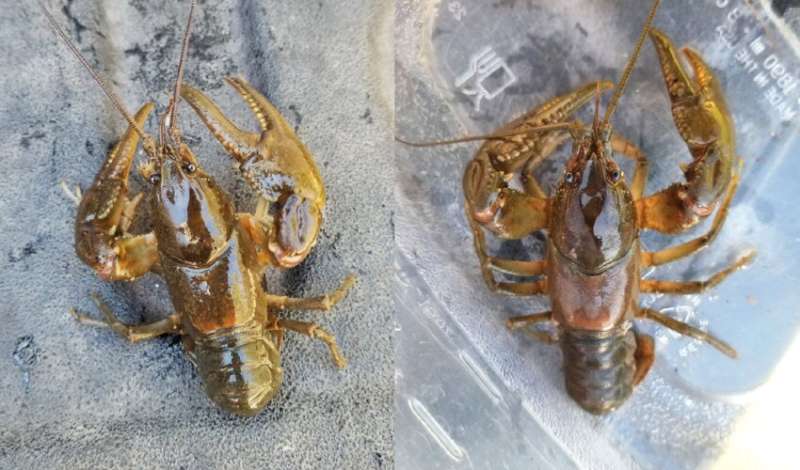This article has been reviewed according to Science X's editorial process and policies. Editors have highlighted the following attributes while ensuring the content's credibility:
fact-checked
peer-reviewed publication
reputable news agency
proofread
Two species found 'nowhere else on the planet' documented in western N.C, museum says

A feisty looking crustacean in North Carolina's Blue Ridge Mountains is a new species found nowhere else in the world, according to the North Carolina Museum of Natural Sciences.
Called the Stony Fork Crayfish, it is one of two new species revealed in research by a team of North Carolina scientists published April 20 in Zootaxa. The other species is called the Falls Crayfish.
Both creatures resemble miniature lobsters: The Stony Fork Crayfish is just under 4 inches from nose to tail, and the Falls Crayfish is slightly smaller, the museum reports.
They were discovered "tucked into niches of neighboring streams" that feed into the western upper Yadkin River basin in western North Carolina, officials said.
Bronwyn Williams, a museum research curator of non-molluscan invertebrates, conducted the extremely dirty research nearly six years ago with experts from the N.C. Wildlife Resources Commission.
Williams caught her specimens in a variety of ways, including seine netting and dip netting, as well as "simply flipping rocks."
"I vividly remember catching one of these crayfish ...(and) being really confused. It looked like the Big Water Crayfish, which is known from the complete opposite side of the Eastern Continental Divide, in the Watauga and New Rivers," Williams told McClatchy News.
"But here we were in a smallish tributary to the Yadkin River, which flows the complete opposite direction, into the Atlantic Ocean."
The best explanation is a geologic phenomenon known as stream piracy in which "a waterway erodes into a divide, capturing or diverting an adjacent waterway into itself," the researchers say.
"This is really neat, as it suggests that a previously unknown, localized, temporary, aquatic connection bridged the Eastern Continental Divide near where the headwaters of the Stony Fork and Lewis Fork are now," Williams said in the release.
The two new species live in "highly restricted" ranges, which means they have adapted to specific conditions, the museum says.
Williams worked with Michael Perkins and William Russ from the N.C. Wildlife Resources Commission on the research, officials said.
More information: Michael A. Perkins et al, Integrative taxonomy reveals two new narrowly-endemic crayfish species (Decapoda: Cambaridae) from the Yadkin River Basin in western North Carolina, USA, Zootaxa (2023). DOI: 10.11646/zootaxa.5270.2.3
Journal information: Zootaxa
2023 The Charlotte Observer. Visit charlotteobserver.com. Distributed by Tribune Content Agency, LLC.




















